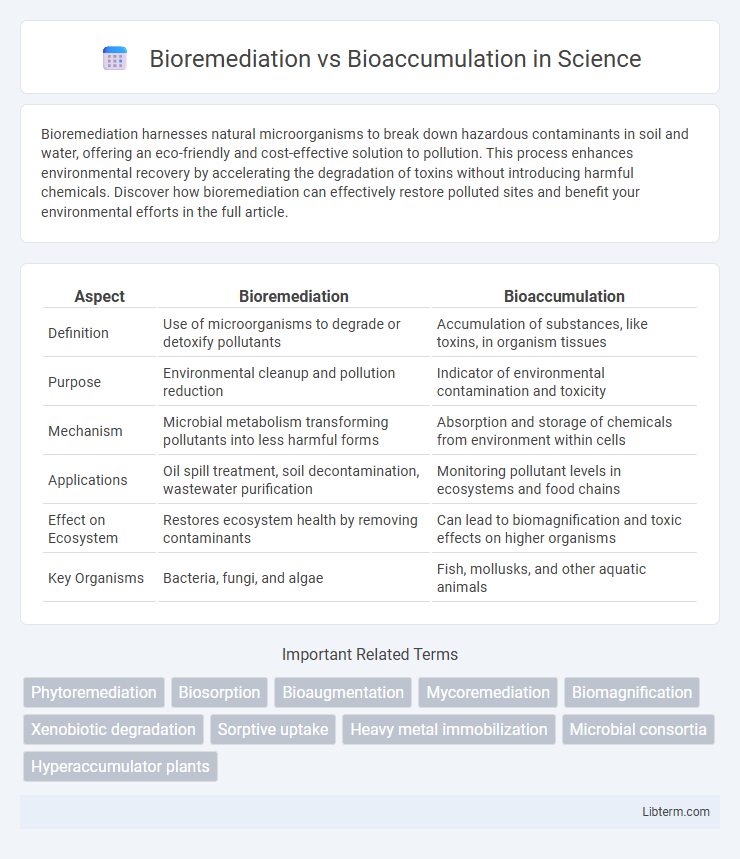Bioremediation harnesses natural microorganisms to break down hazardous contaminants in soil and water, offering an eco-friendly and cost-effective solution to pollution. This process enhances environmental recovery by accelerating the degradation of toxins without introducing harmful chemicals. Discover how bioremediation can effectively restore polluted sites and benefit your environmental efforts in the full article.
Table of Comparison
| Aspect | Bioremediation | Bioaccumulation |
|---|---|---|
| Definition | Use of microorganisms to degrade or detoxify pollutants | Accumulation of substances, like toxins, in organism tissues |
| Purpose | Environmental cleanup and pollution reduction | Indicator of environmental contamination and toxicity |
| Mechanism | Microbial metabolism transforming pollutants into less harmful forms | Absorption and storage of chemicals from environment within cells |
| Applications | Oil spill treatment, soil decontamination, wastewater purification | Monitoring pollutant levels in ecosystems and food chains |
| Effect on Ecosystem | Restores ecosystem health by removing contaminants | Can lead to biomagnification and toxic effects on higher organisms |
| Key Organisms | Bacteria, fungi, and algae | Fish, mollusks, and other aquatic animals |
Introduction to Bioremediation and Bioaccumulation
Bioremediation utilizes microorganisms to degrade or transform harmful pollutants into less toxic forms, effectively cleansing contaminated environments such as soil and water. Bioaccumulation refers to the process where toxic substances, like heavy metals or pesticides, build up in living organisms over time, often magnifying through food chains and posing ecological and health risks. Understanding bioremediation as a sustainable cleanup strategy contrasts with bioaccumulation, which highlights the persistent nature of environmental contaminants within biological systems.
Defining Bioremediation: Methods and Applications
Bioremediation is a process that uses microorganisms, fungi, or plants to detoxify or remove pollutants from contaminated environments, enhancing soil, water, and air quality through natural biological activity. Common methods include bioaugmentation, which involves adding specific strains of microorganisms to accelerate pollutant degradation, and biostimulation, which enhances the growth of indigenous microbes by adjusting environmental conditions like oxygen, nutrients, or pH. Applications of bioremediation span oil spill cleanup, heavy metal removal, and waste water treatment, offering sustainable and cost-effective solutions for environmental restoration.
Understanding Bioaccumulation: Processes and Impacts
Bioaccumulation refers to the gradual accumulation of toxic substances, such as heavy metals and persistent organic pollutants, in an organism's tissues over time, primarily through absorption from the environment or ingestion of contaminated food. This process can lead to harmful concentrations within the organism, impacting its health and potentially biomagnifying through the food chain. Understanding bioaccumulation is crucial for assessing ecological risks and developing effective bioremediation strategies to mitigate pollution in aquatic and terrestrial ecosystems.
Key Differences Between Bioremediation and Bioaccumulation
Bioremediation involves the use of microorganisms to break down and remove environmental pollutants, effectively detoxifying contaminated sites, whereas bioaccumulation refers to the buildup of toxic substances, such as heavy metals or pesticides, within an organism's tissues over time. Bioremediation aims to reduce pollutant concentration in ecosystems through active degradation, while bioaccumulation can lead to biomagnification, causing harmful effects up the food chain. The key difference lies in bioremediation's pollutant elimination goal compared to bioaccumulation's passive pollutant absorption and retention.
Microbial Roles in Bioremediation and Bioaccumulation
Microbial roles in bioremediation involve actively degrading or transforming hazardous pollutants into less toxic forms through enzymatic processes, enhancing environmental cleanup efficiency. In contrast, bioaccumulation involves microbes absorbing and concentrating contaminants within their cells without degrading them, potentially leading to biomagnification in the food chain. Specific bacterial genera such as Pseudomonas and Bacillus are pivotal in bioremediation, whereas certain algae and fungi exhibit strong bioaccumulative capacities for heavy metals and organic pollutants.
Environmental Benefits of Bioremediation
Bioremediation utilizes microorganisms to break down pollutants in soil and water, effectively reducing environmental contaminants and restoring ecosystems. This process mitigates hazardous waste, preventing toxic substances from accumulating in the food chain, unlike bioaccumulation, which involves harmful concentration of toxins in organisms. The environmental benefits of bioremediation include enhanced soil fertility, improved water quality, and minimized ecological risks from industrial pollutants.
Risks and Consequences of Bioaccumulation
Bioaccumulation poses significant environmental and health risks as toxins concentrate in organisms over time, leading to biomagnification in food chains that can result in severe physiological damage or death in wildlife and humans. Unlike bioremediation, which actively degrades or removes contaminants from the environment, bioaccumulation increases toxin levels within organisms, causing long-term ecological imbalances and health hazards such as neurological disorders and reproductive failures. Understanding the consequences of bioaccumulation is critical for managing polluted ecosystems and protecting biodiversity from persistent chemical exposure.
Case Studies: Successful Bioremediation Projects
Successful bioremediation projects, such as the Exxon Valdez oil spill cleanup, demonstrate the efficient use of microorganisms to degrade hydrocarbons in contaminated environments. Case studies from the Chernobyl Nuclear Power Plant site highlight microbial action in reducing radioactive contaminants through bioremediation techniques. Unlike bioaccumulation, where toxins build up in organisms, bioremediation actively removes or neutralizes pollutants, restoring ecological balance in affected sites.
Challenges and Limitations of Both Approaches
Bioremediation faces challenges such as uneven pollutant degradation due to varying microbial activity and environmental conditions like pH and temperature, often requiring long remediation times and extensive site monitoring. Bioaccumulation poses limitations including potential toxicity to organisms accumulating contaminants, biomagnification up the food chain, and the difficulty in controlling pollutant concentrations within biotic systems. Both approaches may struggle with the presence of mixed contaminants and lack of scalability for large or deeply contaminated areas.
Future Trends in Environmental Cleanup: Integrating Bioremediation and Bioaccumulation
Emerging trends in environmental cleanup emphasize the integration of bioremediation and bioaccumulation to enhance pollutant degradation and removal efficiency. Advances in genetic engineering enable the development of microorganisms with optimized metabolic pathways for simultaneous contaminant breakdown and sequestration. Future research is focused on creating synergistic biohybrid systems that leverage microbial communities and bioaccumulative organisms to address complex environmental contaminants sustainably.
Bioremediation Infographic

 libterm.com
libterm.com